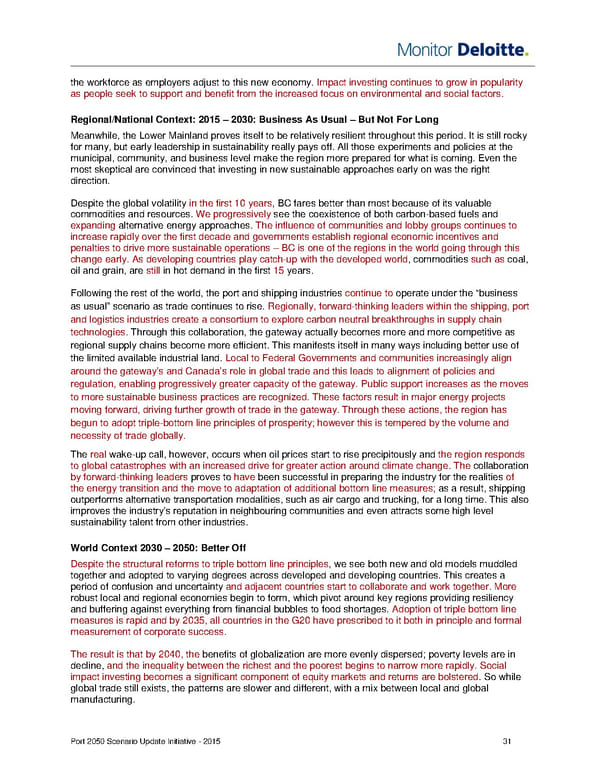the workforce as employers adjust to this new economy. Impact investing continues to grow in popularity as people seek to support and benefit from the increased focus on environmental and social factors. Regional/National Context: 2015 – 2030: Business As Usual – But Not For Long Meanwhile, the Lower Mainland proves itself to be relatively resilient throughout this period. It is still rocky for many, but early leadership in sustainability really pays off. All those experiments and policies at the municipal, community, and business level make the region more prepared for what is coming. Even the most skeptical are convinced that investing in new sustainable approaches early on was the right direction. Despite the global volatility in the first 10 years, BC fares better than most because of its valuable commodities and resources. We progressively see the coexistence of both carbon-based fuels and expanding alternative energy approaches. The influence of communities and lobby groups continues to increase rapidly over the first decade and governments establish regional economic incentives and penalties to drive more sustainable operations – BC is one of the regions in the world going through this change early. As developing countries play catch-up with the developed world, commodities such as coal, oil and grain, are still in hot demand in the first 15 years. Following the rest of the world, the port and shipping industries continue to operate under the “business as usual” scenario as trade continues to rise. Regionally, forward-thinking leaders within the shipping, port and logistics industries create a consortium to explore carbon neutral breakthroughs in supply chain technologies. Through this collaboration, the gateway actually becomes more and more competitive as regional supply chains become more efficient. This manifests itself in many ways including better use of the limited available industrial land. Local to Federal Governments and communities increasingly align around the gateway’s and Canada’s role in global trade and this leads to alignment of policies and regulation, enabling progressively greater capacity of the gateway. Public support increases as the moves to more sustainable business practices are recognized. These factors result in major energy projects moving forward, driving further growth of trade in the gateway. Through these actions, the region has begun to adopt triple-bottom line principles of prosperity; however this is tempered by the volume and necessity of trade globally. The real wake-up call, however, occurs when oil prices start to rise precipitously and the region responds to global catastrophes with an increased drive for greater action around climate change. The collaboration by forward-thinking leaders proves to have been successful in preparing the industry for the realities of the energy transition and the move to adaptation of additional bottom line measures; as a result, shipping outperforms alternative transportation modalities, such as air cargo and trucking, for a long time. This also improves the industry’s reputation in neighbouring communities and even attracts some high level sustainability talent from other industries. World Context 2030 – 2050: Better Off Despite the structural reforms to triple bottom line principles, we see both new and old models muddled together and adopted to varying degrees across developed and developing countries. This creates a period of confusion and uncertainty and adjacent countries start to collaborate and work together. More robust local and regional economies begin to form, which pivot around key regions providing resiliency and buffering against everything from financial bubbles to food shortages. Adoption of triple bottom line measures is rapid and by 2035, all countries in the G20 have prescribed to it both in principle and formal measurement of corporate success. The result is that by 2040, the benefits of globalization are more evenly dispersed; poverty levels are in decline, and the inequality between the richest and the poorest begins to narrow more rapidly. Social impact investing becomes a significant component of equity markets and returns are bolstered. So while global trade still exists, the patterns are slower and different, with a mix between local and global manufacturing. Port 2050 Scenario Update Initiative - 2015 31
 Monitor Deloitte - Final Report Page 32 Page 34
Monitor Deloitte - Final Report Page 32 Page 34